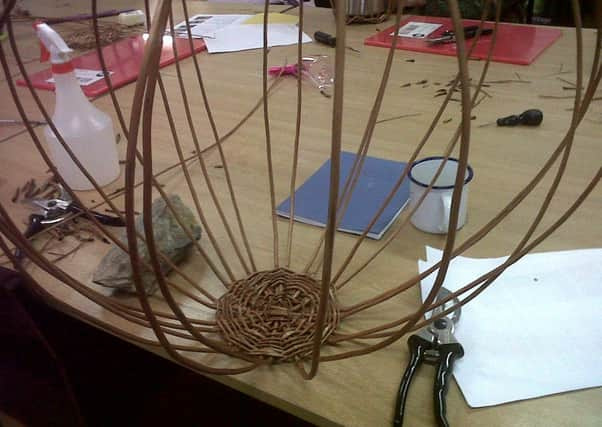The art of weaving willow 3


At the minute at home I am working on enlarging the area of whaling on the basket.
I intend to keep my basket as flat as possible with the aim of recreating an old potato strainer or large, flat serving plate with handles that can be used to serve bread, fruit or potatoes.
Advertisement
Hide AdAdvertisement
Hide AdMy next class will not be until Thursday, October 10, after which I will post another video or two (unless I have the courage to continue on at home).


History of weaving...
In days of old the only way to store or transport things was in a basket. Those baskets were hand made, and everything from chickens to home produce were ferried around in basketware. All storage in the home and in outbuildings were also stored in willow baskets, although anything could have bee used for weaving - reeds, honeysuckle, ivy - if it was pliable or could be soaked to make it pliable, it was used.
A well-woven basket has a life of around 25 years and if weavers could be sourced from nature for free they were a highly efficient and cost effective way to make versatile baskets and storage vessels.
During the Industrial Revolution, baskets were used in factories, and for packing and deliveries and at this time wicker furniture became fashionable in Victorian society. As a child living in Breda Park in Drumahoe I remember my parents having a wicket foot stool modelled on a lobster pot design.
Advertisement
Hide AdAdvertisement
Hide AdDuring the World Warsbaskets were used to transport messenger pigeons. There were also observational balloon baskets, baskets for shell cases and airborne pannier baskets used for dropping supplies of ammunition and food to the troops.
The technique of weaving has been passed along, re-discovered, and expanded upon throughout the years, so while at one time baskets were simply for storage and transportation of goods today, functional baskets are still in use, but many are made for more decorative purposes. Sadly, many hand craft techniques are not as widespread as they once were and modern mechanization took over and now plastic containers seem to dominate whether in the home or in the workplace. So, when I got the chance to learn the basics of willow weaving and basket-making I jumped at it, and enrolled for the Creative Willow Craft Course for four weeks at RAPID on Foreglen Road on the outskirts of Londonderry near Claudy.
The course tutor is Teresa O’Hare, of Orchard Acre Farm in Irvinestown and it is being supported by the Faughan Valley Landscape Partnership Scheme.
Inspired to take this form of craft further, I would be delighted to hear from anyone who remembers willow craft as part of their home life or if they have a relative who is skilled in old-fashioned hand crafting or remember a relative handcrafting things for a living.
To contact me telephone the Londonderry Sentinel on 028 7134 1175 or email me at [email protected].